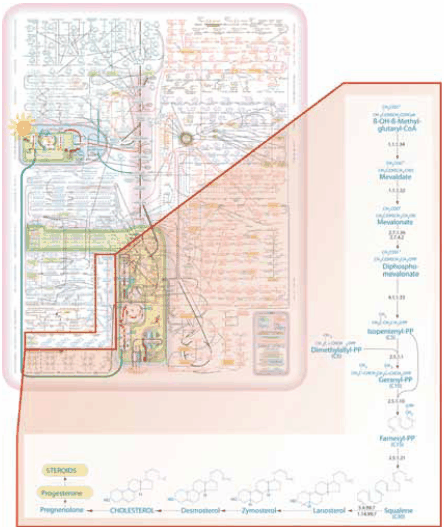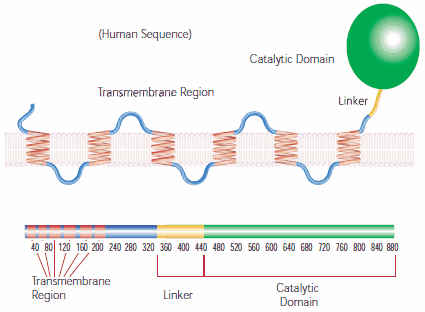Cholesterol Biosynthesis
Cholesterol levels in the body come from two sources, dietary intake and biosynthesis. The majority of cholesterol utilized by healthy adults is synthesized in the liver, which produces ~70% of the total daily cholesterol requirement (~1 gram). The other 30% comes from dietary intake.
Biosynthesis of cholesterol generally takes place in the endoplasmic reticulum of hepatic cells and begins with acetyl- CoA, which is mainly derived from an oxidation reaction in the mitochondria. However, acetyl-CoA can also be derived from the cytoplasmic oxidation of ethanol by acetyl-CoA synthetase. Acetyl-CoA and acetoacetyl-CoA are converted to 3-hydroxy- 3-methylglutaryl-CoA (HMG-CoA) by HMG-CoA synthase.

Figure 1.IUBMB-Nicholson Metabolic Pathways Chart.
HMG-CoA is then converted to mevalonate by HMG-CoA reductase (HMGR). This reaction is completed with the aid of NADPH, which is used as a cofactor for all reduction reactions throughout cholesterol synthesis. Mevalonate undergoes a series of phosphorylations and a decarboxylation yielding the isoprenoid, isopentenyl pyrophosphate (IPP). A series of condensing reactions occur, catalyzed by squalene synthase, leading to the production of squalene. From squalene, lanosterol, the first of the sterols is formed. The conversion of lanosterol to cholesterol requires 19 additional reaction steps.
The conversion of HMG-CoA to mevalonate by HMG-CoA reductase is the rate-limiting step of cholesterol biosynthesis and is under strict regulatory control (Figure 1). HMGR is the target of compounds that are effective in lowering serum cholesterol levels. Human HMG-CoA reductase consists of a single polypeptide chain of 888 amino acids. The amino-terminal residues are membrane bound and reside in the endoplasmic reticulum membrane, while the catalytic site of the protein resides in its cytoplasmic, soluble carboxy-terminal portion. A linker region connects the two portions of the protein.

Figure 1.HMG-CoA Reductase.
3-Hydroxy-3-methyl glutar yl-CoA reductase human
HMG-CoA Reductase ; HMGR Hydroxy-3-methylglutaryl-CoA reductase catalyzes the committed step in cholesterol biosynthesis.
Consists of a single polypeptide chain of 888 amino acids. The amino-terminal residues are membrane bound and reside in the endoplasmic reticulum membrane, while the catalytic site of the protein resides in its cytoplasmic, soluble C-terminal portion. A linker region connects the two portions of the protein.
Supplied as a solution containing 250 μg protein in 50 mM Tris pH 7.5, with 5 mM DTT, 1:200 Protease Inhibitor Cocktail (Catalog Number P8340) and 50% (w/v) glycerol.
≥90% (SDS-PAGE)
activity: 2-8 units/mg protein
One unit will convert 1.0 μmole of NADPH to NADP + per minute at 37 °C. store at: -70 °C
Related Products
To continue reading please sign in or create an account.
Don't Have An Account?